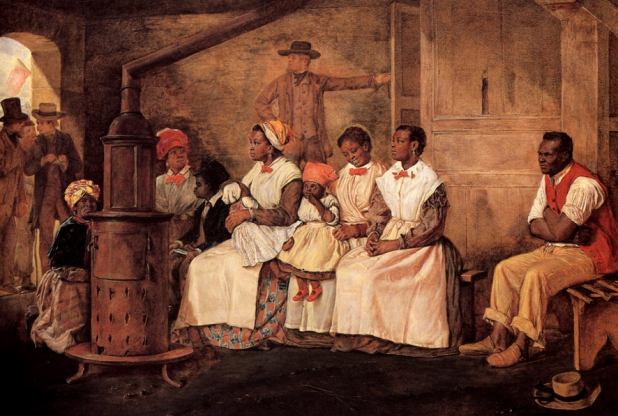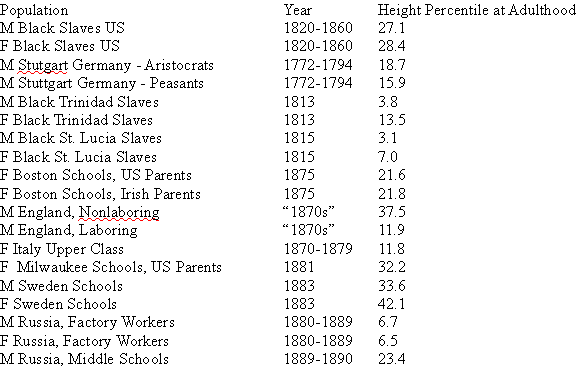Ryan Faulk
The Right Stuff
August 24, 2015

This is a jarring statement at first glance, but I think the evidence is pretty simple and clear. Perhaps to reduce emotionality, replace “slave” with “serf” or “peasant,” which is appropriate since in practice they were the same thing—one system had a Master who owned a slave, the other had a Lord who owned land that a serf was bound to work on.
Both also had a belief that the Master / Lord would often sleep with his subjects’ wives (Prima Noctis or “Right of First Lie”). Nobody has a conniption when the BBC does a documentary saying “English peasants didn’t have it THAT bad,” so it’s not unreasonable to think that chattel slavery in the United States would be a similar story.
Height
Today in the United States, height is mainly a function of genetics, as starvation or chronic hunger is freakishly rare. But until the 1900s, chronic hunger and lack of food was a factor in height, with wealthier populations being visibly taller than poorer ones.
Today, blacks are roughly the same height as whites, very slightly shorter (this surprises some). From the paper “A Peculiar Population: The Nutrition, Health, and Mortality of American Slaves from Childhood to Maturity”, in which Richard Steckel compared height percentiles of black slaves to contemporary white populations at adulthood:
So we can see that, in adulthood, black slaves, despite being roughly the same height as whites today, were taller than most whites in the world, with the exceptions being English aristocrats and Swedes (incl. Swedes in Minnesota). How can this be, if slaves were viciously exploited?
Alienated Labor
Robert Evans Jr., in his paper entitled “The Economics of American Negro Slavery” calculated the return on capital of slaves in the US, and compared it to moneylending and railroads:
So we can see that while black slaves had a higher amount of alienated labor than railroad workers, the highest recorded here was 14.8% profit off their labor. You could speculate it goes up the further back you go—maybe. But the reality is that, after expenses, black slaves got back 80-90% of what they produced on average. And given that the slave plantations were on some of the richest land in the world, it’s not hard to imagine that they were better fed than contemporary whites.
Literacy
In the 1870 census, 20.1% of blacks could read and write, compared to 80% of US whites. That same year Russia had a literacy rate of around 15%. Most African countries didn’t achieve a literacy rate of 20% until around 1950, and India had a literacy rate of 20% in 1950.
One could argue that US whites should have done more to teach blacks to read and write, but the idea that their literacy was kept down by the Atlantic Slave Trade is demonstrably false. Being shipped to the Americas benefited blacks in terms of literacy.
Life Expectancy
While black slaves probably grew to be taller than most whites in the US, their life expectancy was shorter. It’s possible that these are related as caloric restriction is known to increase longevity.
You could look at these as percentages, i.e. what percentage of years do blacks have of whites, but this assumes that improvements in medicine and living standards scale linearly in effect. All we can say with certainty is that blacks have always lived shorter lives than whites on average.
Hours and Difficulty of Work
John F. Olsen in his analysis of southern cotton farms and northern farms, came to the conclusion that the average free farmer on a norther farm worked 3,130 hours per year, while the black slave worked 2,798 hours per year between 1850 and 1860.
Robert Fogel in “Time on the Cross” claimed that the gang-system—which usually included black slaves and a white “motivator”—was vastly more efficient, saying, “A slave working on an assembly-line basis in cotton, sugar and tobacco–the Southern staples–produced as much output in 35 minutes as a traditional worker produced in an hour.”.
In other words, while they worked fewer hours, they worked so much harder that it was still worse. However an analyses by Alan Olmstead and Paul Rhode showed that free cotton farms were just as efficient per hour as the touted “gang system”—and they didn’t even count the fact that the “motivator” wasn’t doing any useful work.
So blacks worked fewer hours and there’s no evidence that they worked any harder.
Breaking up Families
According to “The Slave Family, a View from the Slave Narratives” by Stephen Crawford, only 51.1% of black families had both parents co-residing. By 1880 this number had increased to around 70%, which is where it stayed until 1940, when in started to decline. By 2011 only 37% of blacks lived in two-parent households, while 75% of whites did.
The “breaking up families” line on slavery was probably more compelling back when blacks had nuclear families more that 51.1% of the time.
I don’t know of any statistics on the percentage of slaves sold. Remember this is an evergreen “utilities” post, so if you find something contact me and let me know.
Corporal Punishment
I can only find one quantitative record of how often corporal punishment was used, and that is the records of Bennet H. Barrow. The record spans a 23 month period, and over this period he issues 160 whippings, and he had 129 slaves. This averages out to about 0.65 whippings per slave per year.
However, having read through his records, Barrow seems like a bit of a sadist who enjoyed what he did, and so in my opinion Barrow was not typical. But the system made it so that people like Barrow can have as much power over people as he did. That is an unavoidable reality of slavery, and why it’s good that white people worldwide abolished it not only in their countries but around the world.
I am shocked at how difficult it is to find basic corporal punishment data during slavery. You may think something that is so often referenced in film and in essays and presentations on other topics, that the data on it would be easier to find.
The Subjective Texture
If you’ve gone to public schools, these statistics I post here may seem at odds with the “subjective texture of vicarious experience”—i.e. how you feel slavery was, based on the stories and narratives presented in public school.
There is a great book called “They were White and they were Slaves” which is full of personal accounts of a very different world—in fact a world much more similar to today—regarding race and slavery. Here are some examples:
“…You know, boss, dese days dere is three kind of people. Lowest down is a layer of white folks, then in de middle is a layer of colored folks, and on top is de cream, a layer of good white folks…”
“…The slaves saw enough abject poverty, disease, and demoralization among the poor whites… to see their own condition under Ole Massa’s protection as perhaps not the worst of evils.” (Eugene D. Genovese, “‘Rather Be a Nigger Than a Poor White Man’: Slave Perceptions of Southern Yeoman and Poor Whites,” in Toward a New View of America)
“‘When I was a boy,’ recalled Waters Mcintosh, who had been a slave in Sumter, South Carolina, ‘we used to sing, ‘Rather be a nigger than a poor white man.’ Even in slavery we used to sing that.’”
“Gangs of Irish immigrants worked ditching and draining plantations, building levees and sometimes clearing land because of the danger to valuable (negro) slave property …George Templeton Strong, a Whig patrician diarist… considered Irish workmen at his home to have had ‘prehensile paws’ rather than hands. He denounced the ‘Celtic beast’… lrish youths… were sometimes called ‘Irish slaves’ and more frequently ‘bound boys’…” A common joke in the South in the pre-Civil War period was that when Blacks were ordered to work hard they complained that their masters were treating them ‘like Irishmen.’”
“…a slave… expressed no surprise that his master, who was Big Buckra, never associated with white trash. And Rosa Starke, who had been owned by a big planter in South Carolina, reported that poor whites had to use the kitchen door when they went up to the Big House. Her mistress ‘had a grand manner; no patience with poor white folks.’”
“Frederic Law Olmsted, the landscape architect who designed New York’s Central Park, observed bales of cotton being thrown from a considerable height into a cargo ship’s hold. The men tossing the bales somewhat recklessly into the hold were negroes, the men in the hold were Irish. Olmsted inquired about this to a mate on the ship. ‘Oh, said the mate, ‘the niggers are worth too much to be risked here; if the Paddies are knocked overboard or get their backs broke, nobody loses anything.’”
“John Randolph of Roanoke, traveling in England and Ireland with his black manservant Johnny, wrote to a friend back home: ‘Much as I was prepared to see misery in the south of Ireland, I was utterly shocked at the condition of the poor peasantry between Limerick and Dublin. Why sir, John never felt so proud of being a Virginia slave. He looked with horror upon the mud hovels and miserable food of the white slaves, and I had no fear of his running away.”
Obviously the book and its quotes only tell one side of the story, but that’s the whole point—to serve as counter-bias. I’m not saying that these narratives prove me correct, just that there is a whole ocean of contemporary narrative that backs up my statistical claims. And these narratives portray the United States as having the same crust of anti-white elites who prefer foreigners to “poor white trash.”
Now, why you have never heard these narratives is a whole topic unto itself.



